The global emergency transfer vacuum mattress market is valued at USD 101.4 million in 2025. It is slated to reach USD 166.8 million by 2035, recording an absolute increase of USD 65.4 million over the forecast period. This translates into a total growth of 64.5%, with the market forecast to expand at a CAGR of 5.1% between 2025 and 2035. The market size is expected to grow by nearly 1.64X during the same period, supported by increasing adoption of advanced patient immobilization technologies in emergency medical services, growing awareness of spinal injury management protocols during pre-hospital care, and rising emphasis on safe patient transfer procedures and trauma response capabilities across diverse hospital emergency departments, fire rescue operations, and industrial safety applications.
Between 2025 and 2030, the emergency transfer vacuum mattress market is projected to expand from USD 101.4 million to USD 130.1 million, resulting in a value increase of USD 28.7 million, which represents 43.9% of the total forecast growth for the decade. This phase of development will be shaped by increasing emergency medical service fleet modernization and equipment standardization, rising adoption of vacuum immobilization technology in trauma protocols, and growing demand for lightweight and durable patient transfer solutions in ambulance services. Emergency medical equipment suppliers and hospital procurement departments are expanding their vacuum mattress capabilities to address the growing demand for safe immobilization solutions that ensure patient stability and clinical effectiveness during critical transport scenarios.
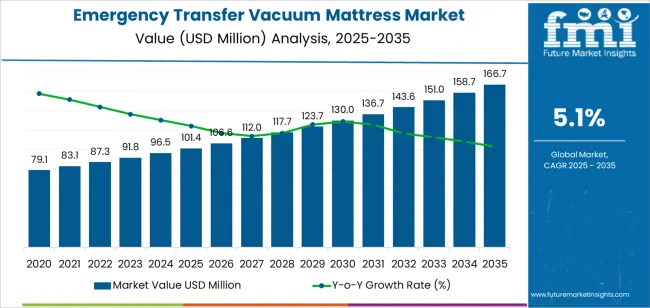
From 2030 to 2035, the market is forecast to grow from USD 130.1 million to USD 166.8 million, adding another USD 36.7 million, which constitutes 56.1% of the ten-year expansion. This period is expected to be characterized by the expansion of disaster response preparedness programs and mass casualty incident equipment stockpiling, the development of antimicrobial surface treatments and infection control enhancements, and the growth of specialized applications for military medical evacuation and remote area rescue operations. The growing adoption of evidence-based emergency care protocols and standardized patient handling procedures will drive demand for emergency transfer vacuum mattresses with enhanced conformability and rapid deployment features.
Between 2020 and 2025, the emergency transfer vacuum mattress market experienced steady growth, driven by increasing recognition of proper spinal immobilization techniques and growing awareness of emergency transfer vacuum mattresses as essential equipment for preventing secondary injuries during patient extraction and transport in diverse trauma situations, rescue operations, and emergency medical response applications. The market developed as emergency medical technicians and trauma physicians recognized the potential for vacuum mattress technology to provide superior patient comfort, improve immobilization effectiveness, and support optimal care delivery while meeting clinical protocol requirements. Technological advancement in valve design and material durability began emphasizing the critical importance of maintaining vacuum integrity and achieving consistent molding performance in challenging emergency response environments.
| Metric | Value |
|---|---|
| Estimated Value in (2025E) | USD 101.4 million |
| Forecast Value in (2035F) | USD 166.8 million |
| Forecast CAGR (2025 to 2035) | 5.1% |
Market expansion is being supported by the increasing global demand for effective patient immobilization solutions driven by rising trauma incident rates and advancing emergency medical service protocols, alongside the corresponding need for specialized medical equipment that can provide full-body support, minimize movement during transport, and maintain patient safety across various emergency medical response, fire rescue, industrial accident, and military evacuation applications. Modern emergency medical service providers and hospital emergency departments are increasingly focused on implementing vacuum mattress solutions that can conform to patient anatomy, distribute pressure evenly, and provide consistent immobilization effectiveness in demanding field conditions.
The growing emphasis on evidence-based trauma care and clinical guideline adherence is driving demand for emergency transfer vacuum mattresses that can support optimal spinal precautions, enable efficient patient packaging, and ensure comprehensive safety during extraction and transport operations. Emergency medical service organizations' preference for immobilization equipment that combines clinical effectiveness with durability and ease of deployment is creating opportunities for innovative vacuum mattress implementations. The rising influence of disaster preparedness planning and mass casualty response capabilities is also contributing to increased adoption of emergency transfer vacuum mattresses that can provide superior patient stabilization without compromising operational efficiency or clinical outcomes.
The market is segmented by product type, application, and region. By product type, the market is divided into split vacuum mattress and pad and mattress. Based on application, the market is categorized into hospital & clinic, fire rescue, industrial safety, police & military, and others. Regionally, the market is divided into China, India, Germany, Brazil, United States, United Kingdom, and Japan.
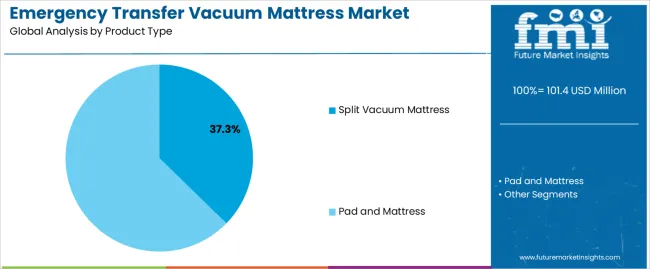
The split vacuum mattress segment is projected to maintain its leading position in the emergency transfer vacuum mattress market in 2025 with a 37.3% market share, reaffirming its role as the preferred product configuration for comprehensive patient immobilization and versatile emergency response applications. Emergency medical service providers and rescue teams increasingly utilize split vacuum mattresses for their enhanced adaptability characteristics, improved patient access options, and proven effectiveness in facilitating medical interventions while maintaining spinal stabilization. Split vacuum mattress technology's proven effectiveness and operational versatility directly address the industry requirements for flexible patient management and efficient care delivery across diverse trauma scenarios and transport situations.
This product segment forms the foundation of modern emergency medical protocols, as it represents the configuration with the greatest contribution to clinical versatility and established performance record across multiple emergency response applications and patient presentations. Emergency medical service investments in advanced immobilization technologies continue to strengthen adoption among ambulance services and rescue organizations. With operational pressures requiring enhanced patient access and maintained immobilization integrity, split vacuum mattresses align with both clinical objectives and practical requirements, making it the central component of comprehensive patient stabilization strategies.

The hospital & clinic application segment is projected to represent the largest share of emergency transfer vacuum mattress demand in 2025 with a 72.9% market share, underscoring its critical role as the primary driver for vacuum mattress adoption across emergency departments, trauma centers, and inter-facility patient transfer operations. Healthcare facilities prefer emergency transfer vacuum mattresses for patient handling due to their exceptional immobilization capabilities, pressure distribution benefits, and ability to maintain patient stability during diagnostic procedures while supporting clinical assessment requirements and preventing secondary complications. Positioned as essential equipment for modern emergency medicine, emergency transfer vacuum mattresses offer both clinical advantages and operational reliability.
The segment is supported by continuous innovation in emergency medical equipment and the growing availability of advanced mattress designs that enable superior patient outcomes with enhanced comfort and reduced procedure time. Hospitals are investing in comprehensive trauma care equipment programs to support increasingly sophisticated emergency protocols and patient expectations for optimal pre-hospital and in-hospital care. As trauma volume increases and clinical standards advance, the hospital & clinic application will continue to dominate the market while supporting enhanced immobilization utilization and emergency care optimization strategies.
The emergency transfer vacuum mattress market is advancing steadily due to increasing demand for effective patient immobilization technologies driven by rising awareness of proper spinal precaution techniques and growing adoption of standardized trauma protocols that require specialized equipment providing enhanced patient stabilization and safety benefits across diverse emergency medical service, fire rescue, industrial emergency response, and military medical evacuation applications. The market faces challenges, including budget constraints in emergency medical service organizations and public safety agencies, competition from traditional spinal board immobilization methods, and training requirements related to proper vacuum mattress deployment and maintenance procedures. Innovation in antimicrobial materials and rapid-deployment mechanisms continues to influence product development and market expansion patterns.
The growing emphasis on disaster preparedness is driving demand for emergency transfer vacuum mattresses that address unique mass casualty incident requirements including rapid deployment capabilities, stockpile storage efficiency, and multi-patient scenario compatibility for natural disasters and large-scale emergencies. Mass casualty response systems require advanced vacuum mattress solutions that deliver effective immobilization across diverse patient populations while maintaining cost-effectiveness and extended shelf life. Emergency management agencies are increasingly recognizing the competitive advantages of vacuum mattress stockpiling for comprehensive disaster response and regional mutual aid systems, creating opportunities for innovative mattress designs specifically developed for emergency preparedness applications.
Modern emergency transfer vacuum mattress manufacturers are incorporating antimicrobial surface treatments and infection prevention technologies to enhance hygiene standards, reduce cross-contamination risks, and support comprehensive infection control objectives through optimized material selection and surface engineering. Leading companies are developing silver-ion embedded materials for bacterial growth inhibition, implementing seamless construction techniques for enhanced cleanability, and advancing coating technologies that maintain antimicrobial effectiveness through repeated cleaning cycles. These technologies improve clinical safety while enabling new deployment opportunities, including hospital emergency departments, ambulance services with high patient volume, and mass casualty incident response scenarios. Advanced antimicrobial integration also allows healthcare organizations to support comprehensive infection prevention objectives and patient safety initiatives beyond traditional immobilization performance attributes.
The expansion of remote area rescue operations, helicopter emergency medical services, and technical rescue applications is driving demand for lightweight emergency transfer vacuum mattresses with exceptional durability and tear resistance meeting demanding field use requirements. These advanced applications require specialized mattress constructions with optimized strength-to-weight ratios that exceed traditional emergency medical equipment specifications, creating premium market segments with differentiated value propositions. Manufacturers are investing in advanced polymer development and reinforcement technologies to serve emerging rescue operation requirements while supporting innovation in wilderness medicine, mountain rescue, and tactical medical support industries.
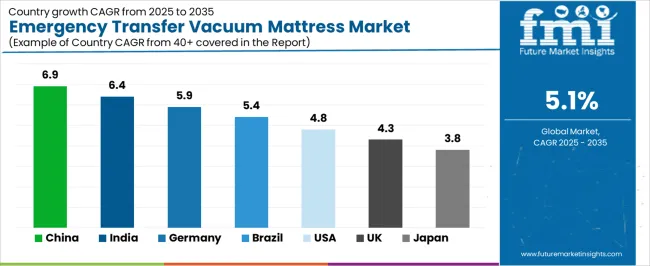
| Country | CAGR (2025-2035) |
|---|---|
| India | 6.4% |
| China | 6.9% |
| Brazil | 5.4% |
| United States | 4.8% |
| Germany | 5.9% |
| United Kingdom | 4.3% |
| Japan | 3.8% |
The emergency transfer vacuum mattress market is experiencing solid growth globally, with China leading at a 6.9% CAGR through 2035, driven by expanding emergency medical service infrastructure, growing hospital emergency department modernization, and increasing adoption of advanced patient immobilization equipment in urban centers. India follows at 6.4%, supported by emergency medical service expansion, growing trauma care awareness, and increasing investment in ambulance fleet equipment upgrades. Germany shows growth at 5.9%, emphasizing rescue service excellence, comprehensive emergency medical training, and precision medical equipment standards. Brazil demonstrates 5.4% growth, supported by emergency medical service development, urban rescue service expansion, and growing awareness of proper patient immobilization techniques. The United States records 4.8%, focusing on emergency medical service protocol standardization, trauma system development, and advanced patient handling equipment adoption. The United Kingdom exhibits 4.3% growth, emphasizing ambulance service modernization and national health service equipment procurement. Japan shows 3.8% growth, supported by disaster preparedness programs and aging population emergency care requirements.
The report covers an in-depth analysis of 40 countries, with top-performing countries highlighted below.
Why is China Leading Global Market Growth with Emergency Medical Service Infrastructure Expansion?
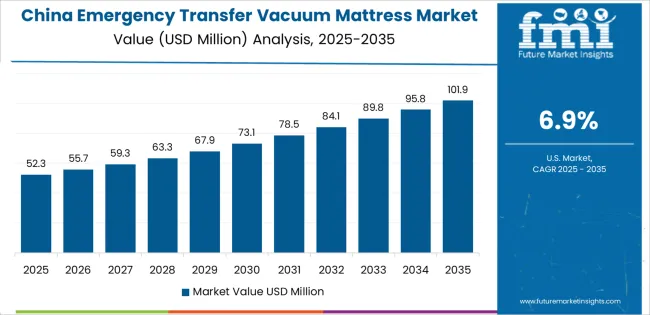
Revenue from emergency transfer vacuum mattresses in China is projected to exhibit exceptional growth with a CAGR of 6.9% through 2035, driven by expanding emergency medical service networks and rapidly growing hospital emergency departments supported by government healthcare infrastructure development initiatives and emergency response system modernization programs. The country's massive healthcare sector expansion and increasing investment in emergency medical equipment are creating substantial demand for vacuum mattress solutions. Major medical equipment manufacturers and hospital procurement organizations are establishing comprehensive equipment sourcing capabilities to serve both urban markets and expanding regional emergency services.
Government support for emergency medical service development and trauma care capacity building is driving demand for emergency transfer vacuum mattresses throughout major cities and provincial centers across hospital emergency departments, ambulance services, and fire rescue organizations. Strong emergency medical service growth and an expanding network of trauma centers are supporting the rapid adoption of vacuum immobilization technologies among healthcare providers seeking enhanced patient care capabilities and clinical protocol compliance.
What is Driving Strong Market Potential in India with Emergency Medical Service Growth and Trauma Care Development?
Demand for emergency transfer vacuum mattresses in India is expanding at a CAGR of 6.4%, supported by the country's developing emergency medical service infrastructure, expanding private ambulance operations, and increasing demand for professional patient immobilization equipment in metropolitan and tier-two city emergency response systems. The country's growing healthcare awareness and emergency service professionalization are driving sophisticated vacuum mattress adoption throughout urban centers. Leading ambulance service providers and hospital networks are establishing extensive equipment standardization programs to address growing quality standards and clinical effectiveness requirements.
Rising road traffic accident rates and expanding emergency medical service coverage are creating opportunities for emergency transfer vacuum mattress deployment across ambulance fleets, hospital emergency departments, and industrial medical response teams in major urban areas and industrial zones. Growing government focus on emergency healthcare access and trauma mortality reduction is driving adoption of evidence-based immobilization technologies among emergency service providers seeking enhanced patient outcomes and care quality.
How is Germany Demonstrating Technological Leadership with Rescue Service Excellence and Equipment Standards?
Revenue from emergency transfer vacuum mattresses in Germany is anticipated to grow at a CAGR of 5.9%, supported by the country's comprehensive rescue service system, established emergency medical training programs, and strong medical equipment quality standards ensuring optimal patient immobilization and care delivery. The nation's advanced emergency medical infrastructure and emphasis on clinical excellence are driving sophisticated vacuum mattress capabilities throughout rescue organizations. Leading rescue service providers and medical equipment manufacturers are investing extensively in equipment innovation and training program development.
Advanced rescue service protocols and comprehensive emergency medical technician training are creating demand for high-quality emergency transfer vacuum mattresses among rescue organizations seeking superior patient immobilization reliability and clinical effectiveness. Strong emergency medical culture and growing focus on evidence-based protocols are supporting the adoption of vacuum immobilization systems in ambulance services and fire rescue operations across federal states and municipalities.
What is Fueling Brazil’s Focus on Emergency Medical Service Development and Urban Rescue Expansion?
Demand for emergency transfer vacuum mattresses in Brazil is projected to expand at a CAGR of 5.4%, supported by the country's developing emergency medical service systems, expanding fire department rescue capabilities, and increasing emphasis on professional patient handling equipment in urban areas and major cities. The nation's comprehensive urbanization and emergency service modernization are driving demand for patient immobilization solutions. Emergency medical service providers and fire departments are investing in equipment acquisition programs and training initiatives to serve both emergency response and inter-facility transfer requirements.
Advanced trauma care development and emergency medical service professionalization are creating demand for effective vacuum mattress technologies among emergency service organizations seeking superior patient stabilization capabilities and protocol compliance. Strong urban emergency service growth and expanding private ambulance sector are driving adoption of vacuum immobilization equipment in metropolitan fire departments, ambulance companies, and hospital emergency services across major urban centers.
How is the United States Prioritizing Protocol Standardization and Trauma System Integration?
Revenue from emergency transfer vacuum mattresses in the United States is growing at a CAGR of 4.8%, supported by the country's established emergency medical service systems, comprehensive trauma center networks, and growing emphasis on evidence-based patient handling protocols requiring validated immobilization equipment. The nation's mature emergency medical infrastructure and clinical research capabilities are driving demand for proven vacuum mattress solutions. Emergency medical service agencies and hospitals are investing in equipment replacement cycles and clinical guideline implementation to serve both urban and rural emergency medical coverage areas.
Advanced trauma system requirements and national emergency medical service standards are creating demand for clinically validated emergency transfer vacuum mattresses among emergency medical service providers seeking optimal patient outcomes and liability risk management. Strong emergency medical education infrastructure and growing focus on spinal motion restriction protocols are driving adoption of vacuum immobilization technologies in ambulance services and hospital emergency departments across regional emergency medical service systems.
What Makes the United Kingdom a Leader in Emergency Care Excellence with National Health Service Procurement?
Demand for emergency transfer vacuum mattresses in the United Kingdom is expanding at a CAGR of 4.3%, driven by the country's comprehensive ambulance service network, standardized emergency medical protocols, and national health service equipment procurement programs supporting consistent patient immobilization practices across regions. The United Kingdom's emergency medical service sophistication and clinical governance frameworks are driving vacuum mattress adoption throughout ambulance trusts. National health service organizations and ambulance service providers are establishing comprehensive equipment standardization initiatives for quality assurance and clinical effectiveness.
Advanced ambulance service standards and national clinical guidelines are creating demand for approved emergency transfer vacuum mattress systems among ambulance trusts seeking enhanced compliance capabilities and clinical audit readiness. Strong clinical governance culture and national health service procurement coordination are supporting the adoption of vacuum immobilization equipment throughout ambulance service providers and hospital emergency departments.
Why is Japan Focusing on Advanced Technology for Disaster Preparedness and Aging Population Care?
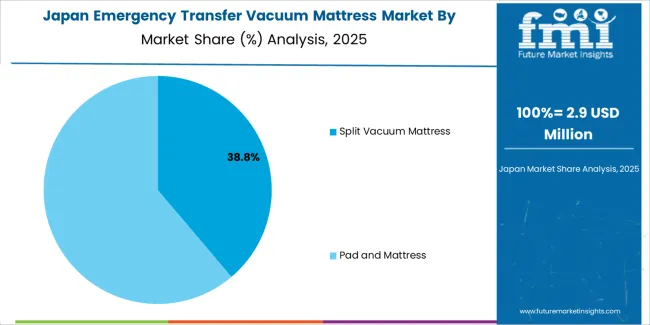
Revenue from emergency transfer vacuum mattresses in Japan is expanding at a CAGR of 3.8%, supported by the country's comprehensive disaster preparedness programs, aging population emergency care requirements, and strong emphasis on equipment reliability for earthquake response and mass casualty scenarios. Japan's disaster readiness culture and emergency medical precision are driving demand for reliable vacuum mattress products. Emergency medical service providers and fire departments are investing in specialized capabilities for disaster response applications and elderly patient transport.
Advanced disaster preparedness planning and aging society healthcare needs are creating opportunities for emergency transfer vacuum mattresses throughout fire department rescue units and ambulance service organizations. Strong disaster preparedness culture and emergency response discipline are driving adoption of vacuum immobilization technologies in municipal fire departments and disaster medical assistance teams meeting rigorous operational and reliability standards.
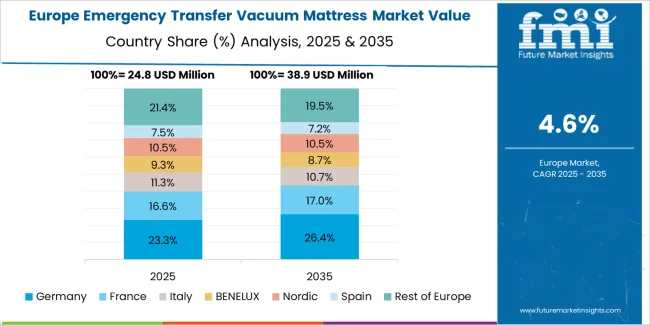
The emergency transfer vacuum mattress market in Europe is projected to grow from USD 37.3 million in 2025 to USD 72.9 million by 2035, registering a CAGR of 7.0% over the forecast period. Germany is expected to maintain leadership with a 29.8% market share in 2025, moderating to 28.6% by 2035, supported by comprehensive rescue service systems, emergency medical training excellence, and strong medical equipment quality standards.
The United Kingdom follows with 24.5% in 2025, projected at 23.7% by 2035, driven by national health service ambulance procurement, standardized emergency protocols, and comprehensive emergency medical service coverage. France holds 19.2% in 2025, reaching 19.8% by 2035 on the back of fire brigade emergency medical services and national emergency response coordination. Italy commands 13.7% in 2025, rising slightly to 14.1% by 2035, while Spain accounts for 8.4% in 2025, reaching 8.9% by 2035 aided by emergency medical service modernization and rescue service equipment upgrades. The Netherlands maintains 4.4% in 2025, up to 4.9% by 2035 due to advanced ambulance services and regional trauma system integration. The Rest of Europe region, including Nordics, Central & Eastern Europe, and other markets, is anticipated to hold 0.0% in 2025 and 0.0% by 2035, reflecting concentrated deployment in established emergency medical service systems and rescue organizations.
The emergency transfer vacuum mattress market is characterized by competition among specialized emergency medical equipment manufacturers, diversified medical device companies, and regional rescue equipment suppliers. Companies are investing in material technology advancement, antimicrobial surface development, product design innovation, and application-specific feature enhancement to deliver high-performance, durable, and user-friendly emergency transfer vacuum mattress solutions. Innovation in lightweight construction methods, rapid-deployment mechanisms, and infection control technologies is central to strengthening market position and competitive advantage.
PAX Company leads the market with an 11.0% share, offering comprehensive emergency transfer vacuum mattress solutions with a focus on rescue service applications, durability engineering, and ergonomic design principles across diverse emergency medical service and fire rescue applications. The company provides extensive product configurations with validated performance characteristics and training support for optimal deployment effectiveness. FERNO provides innovative emergency medical equipment with emphasis on patient handling systems and ambulance integration.
Hartwell Medical offers specialized immobilization products with focus on clinical effectiveness and ease of use. Kohlbrat & Bunz delivers rescue equipment with emphasis on alpine rescue and technical rescue applications. Cramer provides emergency medical supplies including patient immobilization systems for sports medicine and emergency care. EGO Zlín specializes in rescue equipment for fire services and technical rescue operations. MeBer focuses on emergency medical products for ambulance services. Oscar Boscarol offers rescue equipment with emphasis on mountain rescue and challenging environments. Royax provides medical equipment for emergency services and healthcare facilities. BuW Schmidt GmbH delivers rescue and emergency medical equipment for professional users. PVS specializes in emergency response equipment and patient handling solutions. Inforest offers rescue equipment for wilderness and technical rescue scenarios. Ambulancemed provides ambulance equipment and emergency medical supplies for emergency service providers.
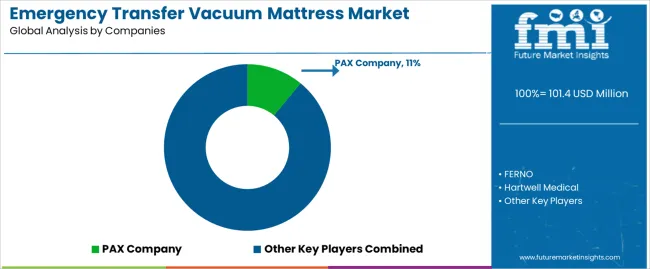
| Items | Values |
|---|---|
| Quantitative Units (2025) | USD 101.4 million |
| Product Type | Split Vacuum Mattress, Pad and Mattress |
| Application | Hospital & Clinic, Fire Rescue, Industrial Safety, Police & Military, Others |
| Regions Covered | China, India, Germany, Brazil, United States, United Kingdom, Japan |
| Countries Covered | China, India, Germany, Brazil, United States, United Kingdom, Japan, and 40 countries |
| Key Companies Profiled | PAX Company, FERNO, Hartwell Medical, Kohlbrat & Bunz, Cramer, EGO Zlín, MeBer, Oscar Boscarol, Royax, BuW Schmidt GmbH, PVS, Inforest, Ambulancemed |
| Additional Attributes | Dollar sales by product type and application category, regional demand trends, competitive landscape, technological advancements in immobilization technology, antimicrobial material innovation, lightweight construction development, and clinical effectiveness optimization |
The global emergency transfer vacuum mattress market is estimated to be valued at USD 101.4 million in 2025.
The market size for the emergency transfer vacuum mattress market is projected to reach USD 166.7 million by 2035.
The emergency transfer vacuum mattress market is expected to grow at a 5.1% CAGR between 2025 and 2035.
The key product types in emergency transfer vacuum mattress market are split vacuum mattress and pad and mattress.
In terms of application, hospital & clinic segment to command 72.9% share in the emergency transfer vacuum mattress market in 2025.






Full Research Suite comprises of:
Market outlook & trends analysis
Interviews & case studies
Strategic recommendations
Vendor profiles & capabilities analysis
5-year forecasts
8 regions and 60+ country-level data splits
Market segment data splits
12 months of continuous data updates
DELIVERED AS:
PDF EXCEL ONLINE
Emergency Communication Vehicle Market Size and Share Forecast Outlook 2025 to 2035
Emergency Lighting Market Growth - Trends & Forecast 2025 to 2035
Emergency Light Sticks Market Analysis and Forecast by Type, Distribution Channel, End Use, and Region through 2035
Emergency Shutdown System Market Trends - Growth & Forecast 2025 to 2035
Emergency Spill Response Market Growth - Size, Trends & Forecast 2025 to 2035
Emergency Medical Services Market Overview – Trends & Industry Outlook 2024-2034
Emergency Vent Cover Market Growth – Trends & Forecast 2024-2034
Emergency Venting System Market Growth – Trends & Forecast 2024-2034
Emergency Response and Rescue Vessels Market
Emergency Beacon Transmitter Market
EMEA Emergency Medical Service Market Analysis by Services, Provider, Fleet, and Region Forecast Through 2035
Railway Emergency Valves Market Trends and Forecast 2025 to 2035
Personal Emergency Response System (PERS) Market Size and Share Forecast Outlook 2025 to 2035
Automatic Emergency Braking System Market Size and Share Forecast Outlook 2025 to 2035
Automatic Emergency Braking (AEB) Market Size and Share Forecast Outlook 2025 to 2035
Drones For Emergency Responders Market Size and Share Forecast Outlook 2025 to 2035
Automotive Emergency Braking System Market - Size, Share, and Forecast 2025 to 2035
Transfer Paper Market Size and Share Forecast Outlook 2025 to 2035
Transfer Switch Market Size and Share Forecast Outlook 2025 to 2035
Heat Transfer Film Market Size and Share Forecast Outlook 2025 to 2035

Thank you!
You will receive an email from our Business Development Manager. Please be sure to check your SPAM/JUNK folder too.
Chat With
MaRIA